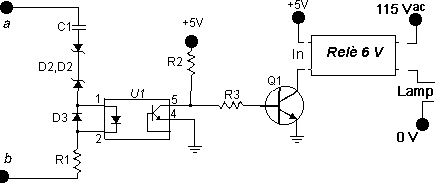| If the answer is positive, is because you had the volume of the Hi-Fi very tall, or because someone had the weak hearing, then this is the proper circuit. Ring detection is often handled with a circuit such as the one show below. The ring signal occurs across tip (green wire) and ring (red wire) or (a and b), and is passed by a dc blocking capacitor. A pair of zener diodes provide bipolar (positive or negative) voltage transient protection. An optoisolator is turned on during half of each ring cycle which, in turn, fires an associated transistor. The Led transmitter and phototransistor receiver are completely isolated from each other, so there is no electrical connection between the HV (High-Voltage) ac ring signal (typically 90 Vac) and the transistor Q1, that pulled up the output signal using a resistor R2 (5 Vdc). As the ringing signal alternates polarity, the optoisolator turns on and off. These transitions produce a digital pulse train at the relay driver transistor Q1. Info: Ringing signals are produced in bursts of between 90 to 120 Vac at a frequency of about 20 Hz. The pattern of these ringing bursts is known as ringing cadence. In the United States, ringing cadence is usually broken into 2 seconds of ringing, and 4 seconds of silence.
Other countries generally use a different ringing cadence. For example, the United Kingdom's ringing cadence consists of two short bursts of 0,4 seconds each, separated by a pause of 0,2 seconds. This pattern is broken up by a 2-second cadence. If you hoop a bright device already climbed on and tested, or you look for it with different characteristics, even that it flashes to the rhythm of the telephone ring, then you would have to specify it in the feedback form and to describe your own preferences. Component's list: R1=8.2K; R2=10K; R3=1K; C1=0.47 uF, 250V; D1,D2=22 V zener; D3=1N4148 diode; Q1=BC337 NPN; U1=4N25 Optoisolator;
RELE'= 6V 10A 1 exchange | a and b=Phone Line |  This circuit works well when connected to a 220 AC Mains Line. |

